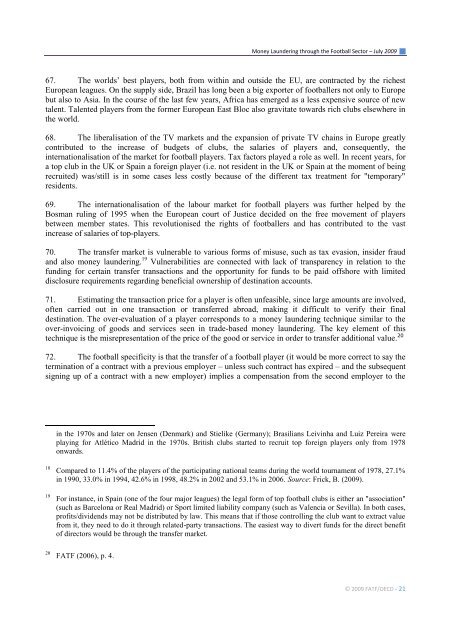Money Laundering through the Football Sector
Money Laundering through the Football Sector
Money Laundering through the Football Sector
You also want an ePaper? Increase the reach of your titles
YUMPU automatically turns print PDFs into web optimized ePapers that Google loves.
<strong>Money</strong> <strong>Laundering</strong> <strong>through</strong> <strong>the</strong> <strong>Football</strong> <strong>Sector</strong> – July 2009 <br />
67. The worlds‟ best players, both from within and outside <strong>the</strong> EU, are contracted by <strong>the</strong> richest<br />
European leagues. On <strong>the</strong> supply side, Brazil has long been a big exporter of footballers not only to Europe<br />
but also to Asia. In <strong>the</strong> course of <strong>the</strong> last few years, Africa has emerged as a less expensive source of new<br />
talent. Talented players from <strong>the</strong> former European East Bloc also gravitate towards rich clubs elsewhere in<br />
<strong>the</strong> world.<br />
68. The liberalisation of <strong>the</strong> TV markets and <strong>the</strong> expansion of private TV chains in Europe greatly<br />
contributed to <strong>the</strong> increase of budgets of clubs, <strong>the</strong> salaries of players and, consequently, <strong>the</strong><br />
internationalisation of <strong>the</strong> market for football players. Tax factors played a role as well. In recent years, for<br />
a top club in <strong>the</strong> UK or Spain a foreign player (i.e. not resident in <strong>the</strong> UK or Spain at <strong>the</strong> moment of being<br />
recruited) was/still is in some cases less costly because of <strong>the</strong> different tax treatment for "temporary"<br />
residents.<br />
69. The internationalisation of <strong>the</strong> labour market for football players was fur<strong>the</strong>r helped by <strong>the</strong><br />
Bosman ruling of 1995 when <strong>the</strong> European court of Justice decided on <strong>the</strong> free movement of players<br />
between member states. This revolutionised <strong>the</strong> rights of footballers and has contributed to <strong>the</strong> vast<br />
increase of salaries of top-players.<br />
70. The transfer market is vulnerable to various forms of misuse, such as tax evasion, insider fraud<br />
and also money laundering. 19 Vulnerabilities are connected with lack of transparency in relation to <strong>the</strong><br />
funding for certain transfer transactions and <strong>the</strong> opportunity for funds to be paid offshore with limited<br />
disclosure requirements regarding beneficial ownership of destination accounts.<br />
71. Estimating <strong>the</strong> transaction price for a player is often unfeasible, since large amounts are involved,<br />
often carried out in one transaction or transferred abroad, making it difficult to verify <strong>the</strong>ir final<br />
destination. The over-evaluation of a player corresponds to a money laundering technique similar to <strong>the</strong><br />
over-invoicing of goods and services seen in trade-based money laundering. The key element of this<br />
technique is <strong>the</strong> misrepresentation of <strong>the</strong> price of <strong>the</strong> good or service in order to transfer additional value. 20<br />
72. The football specificity is that <strong>the</strong> transfer of a football player (it would be more correct to say <strong>the</strong><br />
termination of a contract with a previous employer – unless such contract has expired – and <strong>the</strong> subsequent<br />
signing up of a contract with a new employer) implies a compensation from <strong>the</strong> second employer to <strong>the</strong><br />
in <strong>the</strong> 1970s and later on Jensen (Denmark) and Stielike (Germany); Brasilians Leivinha and Luiz Pereira were<br />
playing for Atlético Madrid in <strong>the</strong> 1970s. British clubs started to recruit top foreign players only from 1978<br />
onwards.<br />
18 Compared to 11.4% of <strong>the</strong> players of <strong>the</strong> participating national teams during <strong>the</strong> world tournament of 1978, 27.1%<br />
in 1990, 33.0% in 1994, 42.6% in 1998, 48.2% in 2002 and 53.1% in 2006. Source: Frick, B. (2009).<br />
19 For instance, in Spain (one of <strong>the</strong> four major leagues) <strong>the</strong> legal form of top football clubs is ei<strong>the</strong>r an "association"<br />
(such as Barcelona or Real Madrid) or Sport limited liability company (such as Valencia or Sevilla). In both cases,<br />
profits/dividends may not be distributed by law. This means that if those controlling <strong>the</strong> club want to extract value<br />
from it, <strong>the</strong>y need to do it <strong>through</strong> related-party transactions. The easiest way to divert funds for <strong>the</strong> direct benefit<br />
of directors would be <strong>through</strong> <strong>the</strong> transfer market.<br />
20 FATF (2006), p. 4.<br />
© 2009 FATF/OECD - 21


